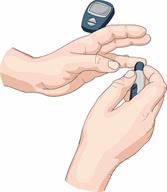Blood Glucose Monitoring, Pediatric
To manage your child's diabetes, you'll need to keep track of their blood sugar. This is called blood glucose monitoring.
Check your child's blood glucose as often as told. Keep a journal of the results over time. This can help you and your child:
Know when to adjust your child's diabetes management plan with their health care provider.
See how food, exercise, illness, and medicines affect your child's blood glucose.
Know what your child's blood glucose is at any time.
Your child's provider will set specific goals for your child's blood glucose levels before and after meals.
Supplies needed:
-
Blood glucose meter.
-
Test strips for your child's meter. Each brand of meter has its own strips. You must use the strips that came with your child's meter.
-
A lancet. This is a sharp device used to poke the finger. Do not use a lancet more than once.
-
A journal or logbook to write down your child's results.
How to check your child's blood glucose
Checking your child's blood glucose

-
Wash your hands and your child's hands with soap and water for at least 20 seconds.
-
Use the lancet to poke the side of your child's finger. Do not prick the tip of their finger. Try not to use the same finger each time.
-
Gently squeeze the finger until a small drop of blood appears.
-
Follow the meter instructions on how to insert the test strip, apply blood to the strip, and use the meter.
-
Write down the result and any notes.
Using different sites
Some blood glucose meters allow testing on other parts of your child's body to test their blood. The most common places are the forearm, the thigh, and the palm of the hand. Check your meter's instructions.
Using different sites may not be as accurate as using the fingers. If you think your child has low blood glucose, use the finger only.
General tips
Blood glucose log

If your child has type 1 diabetes:
- Check your child's blood glucose as often as told by the provider. This may be:
Before every meal.
Two hours after a meal.
At bedtime.
Before and after exercise.
Between 2:00 a.m. and 3:00 a.m.
Before doing things that have a risk of injury, such as riding a bike or driving.
If your child has symptoms of hypoglycemia.
After treating your child's hypoglycemia.
- You may need to check your child's blood glucose more often, such as up to 6–10 times a day, if:
Your child's diabetes is not well controlled.
Your child is ill.
Your child has a history of severe hypoglycemia.
Your child has hypoglycemia unawareness.
If your child has type 2 diabetes:
- Your child may need to have their blood glucose checked 4 or more times a day. Check your child's blood glucose as often as told by the provider. This may include:
Before and after exercise.
If your child has symptoms of hypoglycemia.
After giving your child treatment for hypoglycemia.
Between 2:00 a.m. and 3:00 a.m.
Before doing things that have a risk of injury, such as riding a bike or driving.
- You may need to check your child's blood glucose more often if:
General tips
-
Make sure your child always has their blood glucose meter and supplies with them.
-
After your child uses a few boxes of test strips, adjust their blood glucose meter as needed. Follow the meter instructions.
-
If you have questions or need help, all blood glucose meters have a 24-hour hotline phone number that you can call. Also, contact your child's provider with any questions or concerns.
Contact a health care provider if:
-
Your child's blood glucose is out of their target range. Your child's provider will tell you when you should contact them in these cases.
-
Your child gets a serious illness.
-
Your child has been sick or has had a fever for 2 days or longer and is not getting better.
-
Your child cannot eat or drink.
-
Your child has nausea or vomiting.
-
Your child has diarrhea.
-
Your child's blood glucose is lower than 54 mg/dL (3 mmol/L).
-
Your child becomes very upset, cannot stop crying, or is unresponsive.
-
Your child has trouble breathing.
-
Your child has moderate to high ketone levels in their pee.
These symptoms may be an emergency. Do not wait to see if the symptoms will go away. Get help right away. Call 911.
This information is not intended to replace advice given to you by your health care provider. Make sure you discuss any questions you have with your health care provider.

